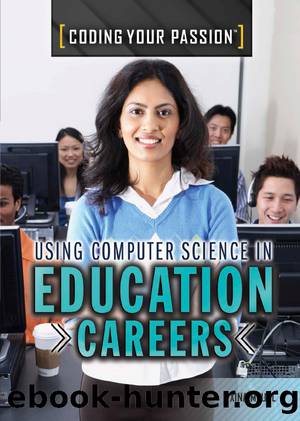Using Computer Science in Education Careers by Xina M. Uhl

Author:Xina M. Uhl
Language: eng
Format: epub
Publisher: The Rosen Publishing Group, Inc
Published: 2019-06-12T00:00:00+00:00
Educational technology, or EdTech, refers to software and other technology designed to improve student learning.
Administrators set a schoolâs policies, and they can encourage teachers to make tech learning a priority. One way administrators can help further this goal is to create flipped classrooms. The concept was made popular by two Colorado high school chemistry teachers. They bought software to allow them to record lessons for absent students and posted them online. Soon, the teachers found that absent students werenât the only ones using the lessons. Other students were using them before class to get a head start on the class. Rather than making the class focus on a teacher giving out information that students have never encountered, a flipped class instead uses class time to work through problems and teach by doing. The idea caught fire and continues to affect classrooms across the country.
A PROGRAMMER WITH A PASSION
When Liz Ruiz got her first job out of college, she had no idea that it would lead to a career in education. Fresh from earning a Bachelor of Science degree in business administration with an emphasis in information systems, Ruiz started working in the data center of a private law school. She worked with the admissions office to process reports. Her next job was at a community college. From there, she went to Los Angeles Unified School District (LAUSD) where she started as a programmer in the geographic information system, or GIS, department, which worked with all sorts of geographical data that corresponded with locations on the earth. Ruiz explains her work:
I was in the data center where I worked with the admissions office to process reports. Eventually I moved to the GIS department. Rather than line-by-line coding, this resulted in maps rather than reports. I worked with a lot of different departments. One was the transportation department, which needed to bus students to magnet schools that focused on certain subjects such as computer science, the arts, zoology, and so on. I helped build maps to determine who would be eligible for bussing. This first involved creating maps of the walk radius of each school, or the area closest to the school where the students would be expected to walk to school. Those students that fell outside of this radius were eligible to be bused in. Maps (done by myself and others) were presented at the Board of Education meetings for the superintendent and board members.
For students interested in GIS, Ruiz recommends that they take classes in cartography, mapmaking, math, databases, GUI, Python, and JavaScript. She also encourages students to try to get into the education industry somehow.
Download
This site does not store any files on its server. We only index and link to content provided by other sites. Please contact the content providers to delete copyright contents if any and email us, we'll remove relevant links or contents immediately.
Harry Potter: A Journey Through a History of Magic by British Library(379)
The Science of Philip Pullman's His Dark Materials by Mary Gribbin(361)
The Basics of Organic Chemistry by Clowes Martin;(353)
Harry Potter and the Sorcerer's Stone: SparkNotes Literature Guide by SparkNotes(319)
Flowers in the Gutter by K. R. Gaddy(288)
Braiding Sweetgrass for Young Adults by Robin Wall Kimmerer(284)
Super Simple Chemistry by D.K. Publishing(279)
Summary of the Selfish Gene by Readtrepreneur Publishing(277)
JavaScript Coding for Teens: A Beginner's Guide to Developing Websites and Games by Yueh Andrew(274)
Exam Success in Geography for IGCSE & O Level by Unknown(268)
Dark days in Salem: the witchcraft trials by Deborah Kent(256)
The Python Audio Cookbook;Recipes for Audio Scripting with Python by Alexandros Drymonitis(256)
Key Immigration Laws by Kathryn Ohnaka(246)
Analysis and Linear Algebra for Finance: Part II by Bookboon.com(245)
Cracking the AP Economics Macro & Micro Exams, 2017 Edition by Princeton Review(237)
Solutions for a Cleaner, Greener Planet: Environmental Chemistry by Marc Zimmer(233)
The Science of Fashion by Julie Danneberg;(225)
Reverse Engineering For Everyone! by mytechnotalent(223)
Cracking the AP Psychology Exam, 2017 Edition by Princeton Review(211)
